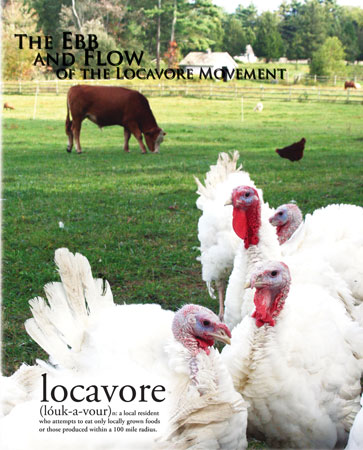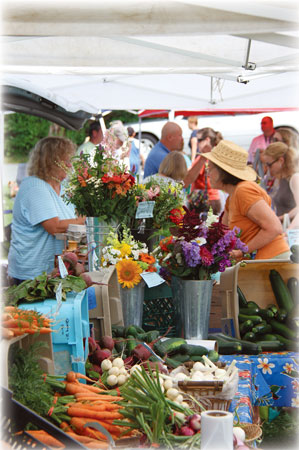
by Lauren Diggin.
Ten years ago, when the first issue of edible South Shore was published, the locavore movement had begun to sweep not just southeastern Massachusetts, but the whole country. Eating locally was on Americans’ minds. In fact, locavore was the New Oxford American Dictionary’s Word of the Year for 2007.

“People have a better understanding now of the world food system and the role of local food in that,” says Karen Schwalbe, Executive Director of Southeastern Massachusetts Agricultural Partnership (SEMAP). Karen says consumers have more choices on where to purchase food locally than they did a decade ago, and our region is able to provide healthy, local food to a greater number of people.
Bay Staters, in particular, are doing a great job eating locally grown food. Massachusetts is among the top ten states in the country in terms of its commitment to local food, according to Strolling of the Heifers’ annual Locavore Index. When the index started in 2012, Massachusetts was 28th on the list—not even in the top half. For 2018, Massachusetts has moved up to number six.
A Locavore’s Journey
For many people, the first step in their locavore journey is a visit to a farmers’ market. This is an easy thing to do in southeastern Mass, especially in the summer. In Bristol and Plymouth counties alone, there are more than 30 different farmers’ markets this season.
Over the last decade, the region’s farmers’ market landscape has evolved, experiencing rapid growth in the number of markets before leveling off and then recently starting to decline. This farmers’ market boom, along with growth in the locavore movement itself, brought changes to the numbers and types of customers and vendors attending markets, as well as to the way markets do business.
While the number of individual farmers’ markets may be declining a little, the overall demand for them is still strong. Some markets have slowed down, while others are as busy as ever, and new markets continue to open. With every boom comes adjustments, and area market managers are taking the changes in stride and figuring out what works for their area and their shoppers.
Lorrie Dahlen, manager of the Marshfield Farmer’s Market, has seen a transition in the customers coming to her market. She notes, “We used to have a very set group of regular customers. Now I feel like we suddenly have to convince a whole new set of people to come in.”
She believes the shift is due in part to the Internet changing the way people shop and where their attention goes. “The crowd looking for local food has dwindled. The true locavores will still come to the market, but more people are buying food online,” said Lorrie.
The Marshfield market has responded by adding an app, Market 2day, that lets customers shop in advance and either pick up their order at the market or have it delivered for a fee if they live in Marshfield and surrounding towns.
Lesley Heyl, manager of the Original Easton Farmer’s Market, thinks farmers’ markets were more popular ten years ago. “People still care about having access to local food, but don’t make it a point to go out to farmers’ markets,” says Lesley. Like Marshfield, her market has some regulars, but not as many as in years past.
She believes the social aspect of farmers’ markets has been lost to some degree, and that markets should continue to be an interactive experience. “The benefit of a farmers’ market is that you have access to everything—one-stop shopping on a small scale,” says Lesley. “Markets are as much an educational opportunity as access to local food.”
Lesley has also noticed that people shop differently now, and says many market managers are looking into delivery. “We have to adapt to the way people want to buy food. That will be the next big wave.”
Further south at the Dartmouth Farmers’ Market, attendance is going strong. “We have a good group of people who live in the area that totally get it and are into local food,” says market manager Susan Murray.
Susan believes the farmers’ market boom has peaked, and that the next step is to bring area markets together to combine marketing efforts and present a united front. The markets in her area have banded together to form the South- Coast Farmers Market Coalition. As markets slow down, Susan feels existing markets should come together to offer an alternative to going to the grocery store.
Like other market managers, Susan knows it’s also important to bring markets online as much as possible and make the buying process easier for people. She says many new services are being offered to markets that let shoppers see what will be available and pre-order, and that the coalition is looking into delivery options.
The Plymouth Farmers’ Market is also as busy as ever. Market manager Dave Purpura has watched attendance grow year after year. “We’ve tried to make the market a destination spot, not just a place where people run to grab kale,” says Dave. “Plymouth is a very community-based market. The same people come out every week. We know people by their first names; we’ve watched their kids grow up.” Every week, the market offers live music, prepared foods, and kids’ activities. Perhaps more importantly, it offers a diverse line-up of high-quality vendors, which Dave says it took years to build. “We try to cover as much of people’s grocery needs for the week as we can.”
The formula is clearly working for the Plymouth Farmers’ Market. Dave credits much of the market’s success to the small army of people who help him each week. But in the end, the market provides a great variety of offerings to the area’s locavores. “The heart of the market is the weekly three, four, or five-minute-long interactions that happen between the vendors and customers,” says Dave.
Business is also still booming at the Braintree Farmers’ Market. Donna Ingemanson, the Braintree market manager, says they always get a diverse crowd and a wide demographic of people who come from towns all over the South Shore. “Strong attendance tells me the locavore movement is strong,” says Donna. The Braintree market has a core group of regulars along with many new faces each week. “People enjoy meeting farmers and learning about new foods, and are drawn to products that tend to be healthier.”
Pam Denholm, who recently closed South Shore Organics and is now with the Weymouth Food Pantry, has seen the same changes as many local market managers. “The local food movement has bloomed, much like the housing market of ten years ago,” says Pam. She thinks a contraction is already in place.

“What’s trending now is the convenience factor,” said Pam, citing things like grocery delivery, AmazonFresh, meal kits, etc. She believes the restrictions of eating locally and eating seasonally are something the mainstream public struggled with, along with lack of convenience. “Whatever the next thing is, it will be super convenient—whatever you want, whenever you want it.”
Even as the locavore movement continues to evolve, it’s changed the local food landscape permanently. “A mind stretched by one idea never goes back to its original form,” quotes Pam. Whether people are going to farmers’ markets less or have decided a CSA isn’t for them, they still have that knowledge, she says. “Mindfulness is here to stay. Interest in being healthful is here to stay.”
Local Products with Mainstream Distribution
Another important, lasting benefit of the locavore movement that Pam saw is how it forced grocery stores and national brands to take consumers seriously and meet demand. There has been substantial growth over the last decade in consumer awareness of labeling, ingredients, and sourcing.
Stop & Shop has taken note of customer desire for more local food and acted on it. Peter Quinn, category manager of produce, says customers frequently contact Stop & Shop through the consumer hotline and store management teams to ask for local options. And the company meets annually with local farmers as a large group to explain the store’s “local” marketing program. “We bring together the farmers, the produce buyers, and the marketing department to explain how we can feature, merchandise and sell their products in our stores,” explains Peter.
It’s a goal of Trucchi’s Supermarkets to bring more fresh and local products to all of its stores. The neighborhood chain of six stores currently offers produce from Cervelli Farm and Jonathan’s Sprouts in Rochester, Almeida’s Vegetable Patch in Swansea, Cabral Farms in North Dighton, 2 Friends Farm in Attleboro, and Ward’s Berry Farm in Sharon.
“Selling locally grown food is good for the local economy,” says Ann Trucchi Condon, Chief Financial Officer. “It makes sense that we should try to grow the local economy from our stores and represent what truly makes up the community.” Ann personally initiated a pilot program in 2015 to sell organic produce from Plato’s Harvest and Golden Rule Farm in Trucchi’s Middleboro stores, where both farms are located.
She believes a community-centric approach can differentiate Trucchi’s. “We want to support our neighbors,” says Ann. “There are a lot of great products being grown locally, and that’s a thing you can do for a person who’s your neighbor–give them the volume.” As consumer demand for organic and locally grown food becomes mainstream, and the perfectly imperfect produce that doesn’t come from factory farms moves off the stores’ shelves, it will be easier for Trucchi’s to grow its local offerings even more and nurture relationships with local farmers.
Farm-to-Table Expanding
The demand for local food has also spread to restaurants. “Farm-to- table ten years ago was new, but now it’s a standard thing for organizations with environmental or agricultural interests to do,” says SEMAP’s Schwalbe.
Allie Wainer, Executive Vice President at Sid Wainer & Son, has watched more and more area restaurants use locally sourced ingredients, and she says this use extends beyond just main entree ingredients. “From beer to cocktail ingredients and fresh herbs on desserts, restaurants are thinking outside the box in order to utilize local products whenever possible. Some are pickling or canning products from local farms so they have access to local year round.”
Allie thinks the increase comes from both customer and chef preferences. “Chefs are cooking more consciously and consumers want to support those who support local farms,” says Allie. “I think that people are starting to understand and embrace exactly how our food gets from the farm to the table.”
When Rye Tavern opened eight years ago, it was one of the region’s only true farm-to-table restaurants. One small garden was able to supply the restaurant with most of its produce. As the restaurant grew, so did area demand for locally grown and sourced food. The tavern now has two gardens, raised beds for herbs, and their own farmer who acts as a local sourcer and stays in constant contact with area farmers.
The farm-to-table concept is so popular now that Rye Tavern offers a long table series every few weeks. The events feature a 4-5 course meal with beverage pairings. According to Chef Andrew Swain, the point is to really have the featured farms stand out. “At most of the dinners, you can sit down and eat with the farmers themselves and get to know how the process really comes to life.”
The Ebb and Flow
The locavore movement has grown and evolved in our region over the last ten years, and while the movement is sure to experience both contraction and growth over the next decade, the health benefits and expanded knowledge of the local and world food system that the movement brought are surely here to stay.
“It’s an evolving landscape. We’ve reached an interesting intersection, and it’ll be fascinating to see where we are in another 10 years,” says Pam.
Wherever that is, it will surely be a more healthful and delicious place for everyone.
Sidenote:
The Market 2day app, created by Hingham resident and local food economy supporter Insa Elliot, helps shoppers find local markets, see which vendors will be there and what they’re bringing, and at some markets, order items to be picked up at the market or even be delivered. Market managers can also use the app to communicate with customers.
Lauren Diggin enjoys writing about local food, but she enjoys eating it even more, and she’s loved watching more farmers’ markets and farm stands open in her neck of the woods over the last ten years.






